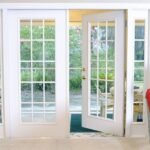Did you know that adding French doors to your home can significantly increase its value? Well, we certainly didn’t until we dug deeper into the topic.
In this article, we’ll explore whether you need planning permission for French doors and provide you with all the information you need to make an informed decision. From understanding permitted development to considering different types of properties, we’ve got you covered.
So, let’s dive in and shed some light on this often confusing topic.
Key Takeaways
- French doors can significantly increase the value of a home.
- Permitted development regulations determine if planning permission is required for alterations.
- Conservation areas and listed buildings may have stricter rules for French door installations.
- Internal changes to the property may also require planning permission.
Introduction
Do you know if you need planning permission to install French doors on your property?
Understanding the regulations regarding permitted development is crucial before making any changes to your doors and windows.
Several location factors come into play when determining if planning permission is required. For instance, the rules may be more stringent if you live in a conservation area or a listed building.
Internal changes, such as altering the internal layout of your property, may also require planning permission.
It is advisable to consult with your local authority to ensure compliance with the regulations specific to your area.
Additionally, different property considerations, such as the size and scale of the proposed changes, may affect the planning permission requirements.
Understanding Permitted Development
Understanding permitted development allows homeowners to make changes to their property without requiring permission from the local authorities. Here are some key points to help you grasp the concept:
- Permitted development benefits: It gives homeowners the freedom to make specific alterations to their property quickly and easily, saving time and money.
- Planning permission process: By following permitted development guidelines, homeowners can avoid the lengthy and often complicated planning permission process.
- Common misconceptions: Some people mistakenly believe that all changes can be done under permitted development, but some restrictions and limitations must be considered.
While permitted development offers many advantages, it’s important to be aware of potential issues, such as neighbourhood objections or restrictions due to conservation areas.
Alternatively, homeowners can choose to go through the planning permission process for more extensive changes. It’s essential to understand the regulations and consult with professionals to ensure compliance and avoid any complications.
Key Factors in Planning Permission
When it comes to planning permission for home improvements, there are several key factors to consider.
Firstly, location matters, as certain areas may have specific restrictions or regulations.
Additionally, replacing standard windows or doors, creating new openings, and adding or replacing doors all fall under permitted development, but it’s important to understand the specific guidelines and limitations.
Lastly, it’s crucial to differentiate between internal and external changes, as the rules and requirements may vary.
Location Matters
Choosing the right location for your French doors is crucial in determining whether or not you need planning permission. Here are some key factors to consider:
- Privacy concerns: Think about the visibility of the area where you intend to install the French doors. If neighbouring properties or public spaces are nearby, you may need to take measures to ensure privacy, such as using frosted glass or installing blinds.
- Security considerations: Assess the security implications of adding French doors in a particular location. Ensure that the doors are fitted with robust locks and consider additional security features like laminated glass or multi-point locking systems.
- Impact on natural light: French doors are known for their ability to bring in natural light, so consider the orientation of the doors in relation to the sun. Positioning them in areas where they can maximize the entry of sunlight can enhance the overall ambience of your space.
Replacing Standard Windows or Doors
Replacing standard windows or doors with French doors typically falls under permitted development, making it a popular choice for homeowners looking to enhance their living space. Window replacement and door installation are common home improvement projects that can significantly transform the look and feel of a property.
However, it is important to know building regulations when undertaking such renovations. While planning permission may not be required for French doors, ensuring that the work complies with building regulations is crucial. These regulations are in place to ensure structural integrity, energy efficiency, and safety.
It is advisable to consult with a professional contractor or local building authority to ensure that the installation meets all necessary requirements. By adhering to building regulations, homeowners can confidently improve their property and enjoy the benefits of beautiful French doors.
Creating New Openings
When it comes to creating new openings for French doors, there are several important factors to consider. Here’s what you need to know:
- Design options: Before creating an opening, you’ll want to consider the design options available. French doors come in various styles and materials, so it’s important to choose one that complements your home’s aesthetics.
- Structural considerations: Opening up a wall for French doors requires careful consideration of the structural integrity of your home. It’s essential to consult with a professional to ensure that the wall can safely support the new opening.
- Cost implications: Creating new openings for French doors can vary in cost depending on factors such as the size of the opening and the materials used. Budgeting accordingly and considering additional costs, such as permits or building regulations, is important.
For expert advice on creating openings for French doors, consulting with a professional contractor or architect who can provide guidance and ensure a successful installation is highly recommended.
Adding or Replacing Doors: Permitted Development
Adding or replacing doors in properties is often allowed without the need for planning permission. This falls under the category of permitted development, which refers to certain types of home improvements that can be made without going through the formal planning process. However, it is important to note that some planning regulations must be followed.
Regarding door materials, a wide range of options are available, including wood, uPVC, aluminium, and composite. The installation process typically involves removing the old door, preparing the opening, fitting the new door, and making any necessary adjustments.
Cost considerations for adding or replacing doors can vary depending on factors such as the type of door, materials used, and any additional work required. It is always recommended to consult a professional to ensure compliance with planning regulations and get an accurate cost estimate.
Internal vs. External Changes
To update the look of your home, consider making internal changes such as repainting walls or rearranging furniture. These simple updates can have a significant impact on the overall appearance of your space.
However, when it comes to external modifications, such as adding or replacing doors like French doors, it’s important to understand the planning regulations and whether or not you need permission. In many cases, larger internal changes may not require planning permission, while external modifications often do.
Here are some key points to consider:
- Internal changes: Repainting walls, rearranging furniture, or adding new fixtures generally do not require planning permission.
- External modifications: Adding or replacing doors and windows or making structural changes to your home usually require planning permission.
- Local authority consultation: It’s always a good idea to consult with your local authority to understand your area’s specific planning regulations and requirements.
Before making any changes to your home, it’s essential to research and understand the permitted development rules and consult with your local authority if necessary.
Consulting the Local Authority
It’s always advisable to consult the local planning authority to obtain accurate information before making any changes to your home. When it comes to installing French doors, it’s essential to understand the planning process and legal requirements.
The local authority consultation is crucial in determining whether you need planning permission or if your installation falls under permitted development rights. Building regulations also play a role in ensuring the safety and compliance of the doors. The local authority can provide guidance on these regulations and any necessary approvals.
If planning permission is required, alternative options, such as applying for a Certificate of Lawfulness or seeking professional advice, can be explored. By consulting the local authority, you can confidently navigate the planning process and ensure that your installation meets all necessary requirements.
Considerations for Different Types of Properties
When considering different types of properties, such as houses, flats, and offices, there are several key points to consider.
Firstly, houses offer the advantage of more space and privacy, making them suitable for families or individuals looking for a larger living space.
On the other hand, flats can be a more affordable option and often come with amenities such as communal areas or security features.
Lastly, offices require careful consideration of location, size, and layout to ensure they meet the business’s specific needs.
Houses
Houses often have greater flexibility in terms of permitted development rights, meaning homeowners have more freedom to make changes without planning permission.
When installing French doors in a house, there are a few important factors to consider:
- Understanding regulations: Even though houses have more lenient development rights, it’s crucial to understand the regulations in your area. There may still be restrictions on door size or location.
- Design options: French doors come in various styles and materials, allowing homeowners to choose the option that best suits their aesthetic preferences and house design.
- Cost considerations: Installing French doors can be a significant investment. Homeowners should consider the cost of materials, installation, and any additional work required, like structural changes or modifications to the surrounding area.
Despite the greater flexibility, potential obstacles may still arise when installing French doors in a house. Researching and planning the project carefully is critical to comply with local regulations and achieve the desired outcome.
Flats and Offices
If you live in a flat or office, it’s important to be aware that the permitted development rights may differ from those of houses. When it comes to making changes to your property, such as installing French doors, additional permissions may be required.
This is especially true for commercial properties, where stricter regulations are often in place to ensure fire safety and compliance with noise regulations. Accessibility requirements may also come into play, as buildings need to be accessible to all individuals.
Before making any alterations, it is crucial to consult with your local planning authority to determine whether planning permission is needed for your specific situation. By doing so, you can avoid any potential legal issues and ensure that your changes are in line with the necessary regulations.
Specific Situations and Questions
Regarding the front door moving and replacing windows with French doors, there are several important factors to consider.
One of the key considerations is whether the changes comply with building regulations, as these regulations ensure the safety and functionality of the property.
Additionally, if the property is a listed building or is located in a conservation area, additional restrictions and permissions may be required before making any alterations.
Front Door Moving
Although moving the front door is possible, you might need planning permission and approval from the local authority. This process can be complex, so it’s important to understand the requirements and rules involved.
Here are some key points to consider:
- Front door relocation: Moving the front door can significantly impact the appearance and functionality of your home. It’s important to carefully plan the new location to ensure it meets your needs.
- Planning permission process: Before making any changes, you’ll need to apply for planning permission. This involves submitting detailed plans and paying a fee. The local authority will assess your application based on factors such as the impact on the surrounding area and the design of the new door.
- Consulting professionals: Given the complexity of the planning permission process and the local authority requirements, it’s advisable to consult professionals such as architects or planning consultants. They can guide you through the process, help you prepare the necessary documents, and increase your chances of approval.
Replacing Windows with French Doors
To replace your windows with French doors, it’s essential to understand the regulations and guidelines in place.
Regarding energy efficiency, French doors can provide better insulation than traditional windows, thanks to their larger glass panels and tighter seals. However, it’s crucial to ensure that the doors meet local energy efficiency standards to maximize energy savings.
Security concerns are another important aspect to consider. Make sure to choose doors with robust locking mechanisms and reinforced glass to prevent break-ins.
Design options abound, with various materials, finishes, and styles available to suit your taste and complement your home’s architecture.
Cost considerations include the purchase and installation of the doors and any necessary modifications to the existing window openings.
Lastly, regular maintenance, such as cleaning and lubricating hinges and locks, will help keep your French doors in optimal condition for years to come.
Building Regulations
Building regulations for doors and windows are separate from planning permission requirements, so it’s important to understand the specific guidelines in place. When it comes to installing French doors, several building regulations need to be considered to ensure safety, energy efficiency, fire safety, and accessibility standards.
Here are three key requirements to keep in mind:
- Safety: Building regulations dictate that French doors must have toughened safety glass to prevent shattering and potential injury. This is especially important if the doors are located in areas where people are likely to come into contact with them.
- Energy Efficiency: French doors should meet certain thermal performance standards to minimize heat loss and improve energy efficiency. This can be achieved through proper insulation and the use of double or triple glazing.
- Fire Safety: If the French doors are installed as an escape route, they must meet specific fire safety requirements. This includes having a clear opening width and a suitable fire resistance rating.
Listed Buildings and Conservation Areas
When considering installing doors or windows in listed buildings or conservation areas, it’s important to know the special considerations that apply.
In the case of listed buildings, these structures are recognized for their historical or architectural significance and are therefore protected by heritage regulations. This means any changes or alterations to the building, including installing French doors, may require planning permission.
On the other hand, conservation areas are designated areas that aim to preserve and enhance the unique character and appearance of the surroundings. In such areas, planning permission may also be necessary for installing French doors, as the local authorities will want to ensure that the changes align with the conservation objectives.
Therefore, before proceeding with any door installations in listed buildings or conservation areas, it is crucial to consult with the relevant authorities to ensure compliance with the heritage regulations and planning permission requirements.
It is crucial to be well-informed and consult the relevant authorities when considering the installation of French doors. Here are three key reasons why this is important:
- Planning process: Understanding the planning process and requirements is essential to ensure a smooth installation. It involves researching local regulations, submitting applications if necessary, and obtaining the appropriate permissions.
- Legal requirements: Complying with legal requirements is crucial to avoid potential legal issues or penalties. These requirements may vary depending on factors such as location, property type, and the type of change being made.
- Professional advice: Seeking professional advice from architects, builders, or planning authorities can provide valuable guidance and ensure compliance with regulations. They can help assess the feasibility of your project, provide insights on specific requirements, and assist with the planning and design process.
Are French Doors and RSJs Subject to the Same Planning Permission Regulations?
Yes, French doors and RSJs for French doors are both subject to the same planning permission regulations. It’s important to check with your local planning authority before any installation to ensure compliance with building regulations and requirements. It’s always best to be informed about the specific rules and guidelines for your area.
Frequently Asked Questions
What Are the Benefits of Installing French Doors in a Property?
Installing French doors on the property offers numerous benefits. They enhance the aesthetics, allow for more natural light, improve ventilation, and increase energy efficiency. Moreover, they can significantly boost the property’s value.
Are There Any Restrictions on the Size or Location of French Doors?
When it comes to French doors, there are regulations regarding size and location. It’s important to follow installation guidelines and be aware of any restrictions. Planning permission may be required, so it’s best to check with local authorities.
Can French Doors Be Installed in Listed Buildings or Conservation Areas?
French doors can be installed in listed buildings or conservation areas, but there are exceptions and guidelines to consider. The installation process varies depending on the style of French doors chosen, and regular maintenance is required.
Do I Need Planning Permission to Replace Existing Windows With French Doors?
We don’t need planning permission to replace existing windows with French doors. However, it’s important to consider cost implications, energy efficiency, security concerns, maintenance requirements, and aesthetic considerations before making any changes to our property.
Are There Any Specific Regulations or Guidelines for Installing French Doors in Flats or
Apartments?
When installing French doors in flats or apartments, it’s essential to consider building regulations, fire safety, noise insulation, privacy concerns, and security measures. These guidelines ensure a safe and comfortable living environment for everyone.
Do I need planning permission to install French doors?
Generally, installing French doors is considered permitted development and does not require planning permission in most cases. However, there are some exceptions if you are in a listed building, conservation area, or the new doors face onto a road. It’s best to check with your local authority.
What are the rules around replacing a window with French doors?
Replacing a window with French doors still falls under permitted development in many cases, not needing planning permission. But you may need approval if enlarging the opening size. Always best to confirm with regulations for your specific property.
Does putting French doors in a garage require planning permission?
Yes, adding French doors or any openings to a garage will require planning permission, as this is considered a material change to the building structure. Garages have different rules than the main house.
Are there any exceptions where I would need permission for French doors?
Listed buildings, conservation areas, and installing doors facing a public road all require planning permission for French doors. Flats and non-residential properties also need permission.
Do regulations differ if I’m in a listed building or conservation area?
Yes, listed buildings and conservation areas typically have tighter regulations, including needing planning permission for new French doors even when replacing existing doors. Always check with the council.
Reference links:
https://www.everest.co.uk/planning-permission/do-i-need-planning-permission-to-move-my-front-door/
https://www.pistonheads.com/gassing/topic.asp
https://www.drawingandplanning.com/do-i-need-planning-permission/i-need-planning-permission-doors-windows/
https://www.mybuilder.com/questions/v/400/french-doors-planning-permission
https://texasmadewindows.com/2022/03/16/do-you-need-a-permit-to-replace-an-exterior-door/








